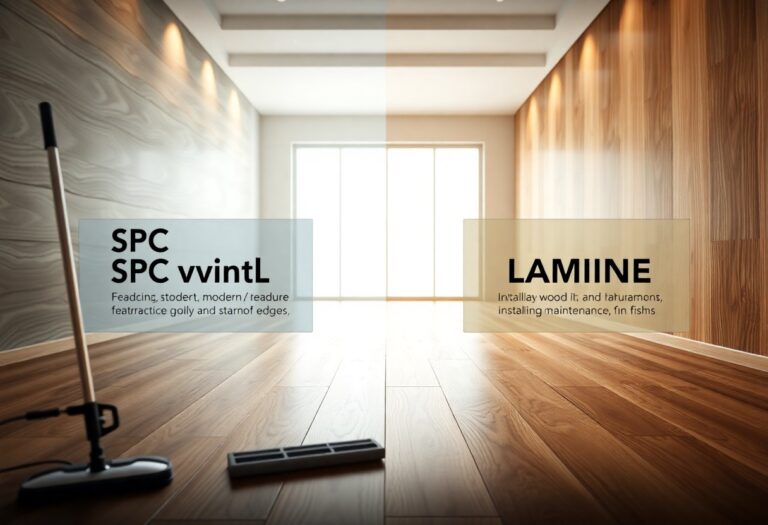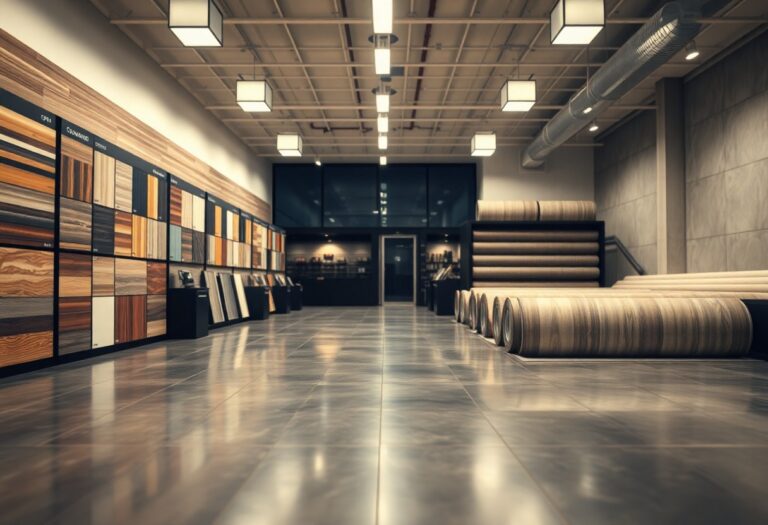Vinyl flooring offers versatility and affordability, making it an appealing choice for many homeowners. However, white oak flooring brings timeless beauty and durability that can enhance your space. As you navigate the decision between these two options, it’s vital to consider factors such as aesthetics, maintenance, cost, and functionality. This guide will help you evaluate both materials to determine which best suits your needs and complements your personal style.
The Aesthetics Duel: Vinyl vs. White Oak
Choosing between vinyl and white oak flooring involves more than just practicality; it’s also about aesthetics. Each material presents unique visual characteristics that can define the overall ambiance of your space. Vinyl offers a range of contemporary designs, while white oak exudes timeless elegance. Your choice will ultimately set the tone for your interiors and influence how each room feels.
Visual Appeal and Style Versatility
Vinyl flooring stands out for its ability to mimic the look of natural materials, including wood and stone, making it suitable for various design styles, from modern to rustic. In contrast, white oak flooring brings an authentic, organic feel that can enhance traditional spaces while still fitting into modern designs. This versatility allows you to create the atmosphere you desire, whether it’s casual chic or sophisticated refinement.
Texture and Finish Differences
The texture and finish of vinyl and white oak flooring significantly impact their visual and tactile appeal. Vinyl often features a smooth surface and can be found in gloss or matte finishes, making it easy to clean and maintain. On the other hand, white oak provides a more varied texture, with natural grains and knots that add depth and character to your floors. Because the beauty of white oak can be highlighted through various finishing techniques, such as satin or distressed finishes, it can complement a wider range of design aesthetics.
White oak’s texture adds not just visual interest but also warmth underfoot. The natural grooves and variations in wood grain provide a unique backdrop that evolves over time, which some homeowners find appealing. As the wood ages, it develops a patina that enhances its beauty. In comparison, while vinyl offers a smooth finish that can resist scratches and stains, it can sometimes lack the character that natural wood possesses. Your choice in texture and finish should ultimately reflect the atmosphere you aim to achieve in your space.
Cost Analysis: Weighing the Financial Impact
Cost considerations play a vital role in your decision-making process between vinyl and white oak flooring. Assessing both the initial investment and long-term value will help you make an informed choice that aligns with your budget and lifestyle.
Initial Investment: Pricing Breakdown
Vinyl flooring typically ranges from $2 to $7 per square foot, making it a more budget-friendly option than white oak. In contrast, white oak installations often cost between $5 to $12 per square foot, not including the additional expenses for professional installation. Depending on your space’s size and your desired aesthetic, the upfront costs can vary significantly.
Long-term Value: Durability and Maintenance Costs
Evaluating the long-term value of vinyl versus white oak hinges on their durability and associated maintenance costs. Vinyl flooring typically requires minimal upkeep, making it practical for busy households, while white oak may demand more attention over the years.
With a lifespan of 10 to 20 years, vinyl flooring is durable enough for everyday use but may show signs of wear over time, particularly in high-traffic areas. On the other hand, white oak can last for decades, often surpassing 50 years with proper maintenance. Maintenance for white oak includes periodic refinishing and cleaning, which protects its beautiful finish but can add to long-term costs. In contrast, vinyl only requires occasional sweeping and mopping. While vinyl appears cheaper at installation, investing in white oak may yield greater value over time, especially if you’re looking for longevity and classic aesthetics.

Environmental Considerations: Sustainability Matters
Making eco-conscious choices can significantly impact your space and the planet. When comparing vinyl flooring and white oak flooring, evaluating the environmental effects of each option is vital. While both materials have their merits, their production processes, longevity, and disposal considerations can influence your decision. Assessing how sustainable each option is will help you align your flooring choice with your values and your living standards.
Production Impact: Eco-Friendliness of Materials
The production processes for vinyl and white oak differ widely in terms of environmental impacts. Vinyl flooring is made from polyvinyl chloride (PVC), a plastic that often entails energy-intensive extraction and manufacturing. On the other hand, white oak, as a natural and renewable resource, can be sourced sustainably from responsibly managed forests, minimizing its carbon footprint. Opting for certified wood can further enhance the eco-friendliness of your choice.
Lifecycle Analysis: Longevity and Disposal
Evaluating the lifecycle of both flooring types reveals important factors about their longevity and disposal. White oak is known for its durability, often lasting 25 years or more with proper care. Although vinyl flooring can also be resilient, its lifespan typically ranges from 10 to 20 years. Disposal methods differ as well, with wood being biodegradable and recyclable, while vinyl often ends up in landfills, posing long-term environmental concerns due to its non-biodegradable nature.
Considering the lifecycle of your flooring choice sheds light on long-term sustainability. White oak can provide substantial value, not only through its durability but also due to its natural properties that allow for easier recycling at the end of its life. In contrast, vinyl poses a challenge in disposal, as millions of tons of PVC waste accumulate yearly. If prioritizing a long-term investment in eco-friendliness is key for you, the benefits of choosing real wood like white oak become even more compelling, both for your home and the environment.
Practical Applications: Best Settings for Both Flooring Options
Your choice of flooring should align with the specific environments and functionalities of your space. Each option has its strengths, making them ideal for different settings. Understanding these practical applications can guide your decision, ensuring that you select the flooring that best suits your needs.
Ideal Environments for Vinyl Flooring
Vinyl flooring excels in moisture-prone areas, such as bathrooms, kitchens, and laundries. Its water-resistant properties make it a practical choice for homes with children or pets. Additionally, vinyl’s durability stands up to high foot traffic, making it a popular option in commercial spaces like offices and retail stores. Its easy maintenance further solidifies its suitability in busy environments.
When to Choose White Oak Over Vinyl
White oak flooring is best suited for spaces where elegance and timeless appeal take precedence over practicality. Its natural aesthetics, durability, and ability to increase property value make it ideal for living rooms, dining areas, and master bedrooms. If your goal is to create a luxurious atmosphere, especially in high-end homes or renovation projects, white oak outshines vinyl.
A well-finished white oak floor not only enhances visual appeal but also adds warmth and character to your home. Its robustness means it can withstand daily wear while developing a beautiful patina over time, adding to its charm. Additionally, white oak’s solid construction often leads to higher resale values, making it a wise investment for homeowners looking to elevate their living spaces. Ultimately, the natural beauty and longevity of white oak make it the preferred choice in settings where aesthetics are paramount, and the investment is justified.
User Experience: Comfort, Safety, and Functionality
Comfort can frequently sway your choice between vinyl and white oak flooring. Vinyl offers a softer feel underfoot, providing some cushioning that natural wood cannot. Its textured surfaces can also help prevent slips, making it a safer option, especially in moisture-prone areas like kitchens and bathrooms. On the other hand, white oak boasts a timeless elegance and durability, contributing to a sense of warmth in your space. Both options serve their functional purposes, but your lifestyle and the specific needs of your household will heavily influence the best choice for your flooring.
Foot Traffic and Longevity Concerns
Vinyl is designed to withstand high foot traffic due to its water-resistant and resilient nature, making it a popular choice in busy family homes. White oak, while durable, may show wear more readily over time, especially in high-traffic areas. However, with proper maintenance, white oak can last for decades, even centuries, providing a long-term investment that can appreciate in value as it ages.
Maintenance Requirements: Cleaning and Care
Both vinyl and white oak flooring have different maintenance needs that can affect your day-to-day life. Vinyl requires minimal upkeep, as it can simply be swept and mopped as needed. White oak, in contrast, needs regular refinishing and care to maintain its luster and appearance. This includes vacuuming, damp mopping, and the occasional application of protective finishes. If you opt for white oak, you’ll want to be prepared for a commitment to its long-term upkeep.
To keep your white oak flooring in top condition, it’s important to use cleaners specifically designed for wood, avoiding harsh chemicals that could damage the surface. Regularly applying a protective sealant can help prevent scratches and wear from everyday use. By being proactive with maintenance, you can extend the life of your hardwood and maintain its natural beauty, making it a worthwhile investment for your home. In contrast, vinyl’s largely hassle-free routine allows it to shine in homes where fast-paced living and minimal fuss are priorities.
Final Words
Taking this into account, choosing between vinyl flooring and white oak flooring ultimately depends on your specific needs and preferences. You should consider factors such as budget, style, durability, and maintenance requirements to make an informed decision. Vinyl flooring offers versatility and ease of upkeep, while white oak provides a timeless, natural aesthetic. Assess your space and lifestyle to determine which flooring option aligns best with your vision and requirements.





